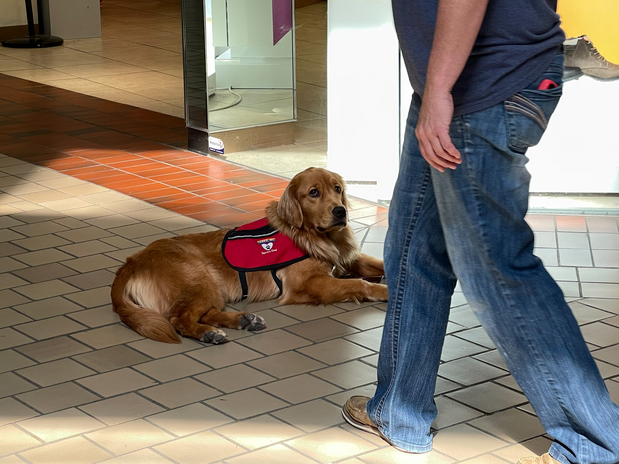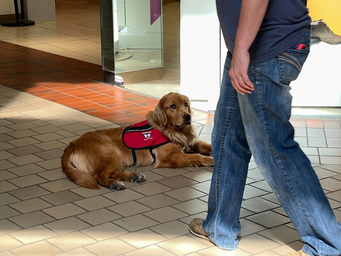During the first week of October, I traveled from western Massachusetts halfway across the country to a little town in Kansas called Concordia to train with and receive a diabetic alert dog. My diabetic alert dog came from a service dog company called CARES. Having been a type 1 diabetic since the age of 6, I have been through many highs and lows (often literally) in my life. I had been on a waitlist for a diabetic alert dog for nearly two years. Having a diabetic alert dog would change my life for the better.

I had first heard of diabetic alert dogs (or DADs, as they are commonly referred to) and CARES five years ago when I was a senior in high school. I had gone to my local library and discovered a book called Elle and Coach written by Stefany Shaheen. The book chronicled the journey that the author’s daughter had with diabetes. Elle was about the same age that I was. A few years before the book came out, Shaheen had heard about diabetic alert dogs from an online search and stumbled upon CARES online. She decided it would be a good resource to help Elle with her diabetes in addition to the modern diabetes technology she already had. So Elle’s family applied. After the two-year wait, Elle was asked to come to Kansas and meet her diabetic alert dog Coach.
The training was held Monday through Friday in a building that is part of a local fairground. When we first got there, they had us come into a large room and sit down. There were approximately 14 other service dog handlers in the class besides me. One by one they brought out the dogs. No one know whose dog was whose until they brought the dog in front of their new handler. After a few people had received their dogs, it was finally my turn. One of the women who ran the training brought the dog by me and had me take the leash. She said, “Julia, this is Pretzel. She is a 14-month-old Golden Retriever.”
As soon as I got Pretzel I was totally in love. She came up to me right away and started kissing me, and I gave her a big hug. It turns out that Pretzel was a member of what they called the “snack” litter theme. Her brothers in the class were Cheeto and Ruffles. Cheeto was going to be a therapy dog at a nursing home and Ruffles was going to be a diabetic alert dog to another adult woman. She also has two other siblings that are still in training and their names are Puff and Chex. Pretzel was born at a volunteer’s home and then went to be part of a service dog training program at a prison in Indiana when she was approximately 8 weeks old. She stayed there until she was about 8 months. She then went to live and train in another home. Finally, she came back to the CARES facility to take part in the last steps of the training and get ready to go be a service dog and help someone out.
Besides Pretzel’s litter, there were Labrador Retrievers named after Star Wars (Leia, Kenobi, etc.), Black Labs named after hospitals (Cornell, Hopkins, etc.), an English Mastiff, a Bernadoodle, and a Poodle. Many people who took part in the training were getting therapy dogs for their schools. A group of people who came down from Canada were all getting PTSD dogs.
During the five-day training, we learned a lot of commands to use with Pretzel. While Pretzel is my dog, my mom also had to learn her commands in case I am sick or I have a diabetic emergency. The commands we learned included, “stop,” “wait,” “follow,” “leave it,” “no,” “take a break (bathroom),” “heel,” “sit,” “come,” “no sniff,” “up,” “off,” “stay,” and “down,” among others. All of these commands ensure she will behave in public (and at home). A big part of the class was leaving the dog and making sure they stayed and layed down until they were told to stand. Another major part of the training was distraction work. This included not eating food on the ground, and ignoring other dogs and toys. Since the dogs are trained in prisons, loud noises do not bother them at all.
The command I will use the most is “check.” This means it is time for Pretzel to alert me to my blood sugar. Eventually, after we get used to each other, she will be able to know what my blood sugar is (before I even know I am low or high!) and I won’t have to remind her to check. She has done this a few times by herself already, but I also tell her what to do. The service dog company said it might take her a few months to learn. She did do a great job at it during the training though.

So how do diabetic alert dogs work? Dogs, in general, can smell at a rate at least 10,000 times stronger than humans. When diabetics have high or low blood sugar our bodies give off a distinct scent that only dogs can smell. Some diabetic alert dogs train with swabs of people’s saliva that customers send in when they are too high or too low. However, CARES finds this method ineffective because scent samples can be contaminated in the mail. Instead, CARES trains all medical alert dogs to look for new scents coming from their human. The coolest thing is that even dogs who don’t specifically train to be diabetic alert dogs are still able to tell when someone’s blood sugar is going too high or too low. I got to see this firsthand when my blood sugar dropped low during our graduation ceremony and three of the other dogs who were trained to do different tasks alerted me.
Unfortunately, diabetic alert dogs (or any service dog for that matter) are not covered by medical insurance. In order to get Pretzel, I did a lot of fundraising work on GoFundMe. CARES only charges $5,000 for their dogs. While this does seem like a lot of money, many service dog companies charge anywhere between $15,000-$30,000. The closest thing to free service dogs is the PAWS Act, recently signed into law by President Joe Biden to help veterans get service dogs.
At the end of the week, every dog and handler in the class had to complete a public access test in order to become a full-fledged service dog and handler team. The test involved going to a busy shopping mall. The test was to check that the dogs could behave in public with no incidents. Each dog passed with flying colors. After passing the public access test, there was a graduation ceremony for all the teams. It was a really special moment I will cherish.

Pretzel has been home with me for almost three weeks now. I am happy to say she is coming along well. Each time I am high or low, I have her sniff me. After she sniffs me, she gets a treat. She has alerted me to my blood sugar being out of range a few times independently, which is fantastic. The service dog company said that by the time I have Pretzel for six months (or even earlier), she will know my blood sugar better than I do. I am so happy that I have a friend in the fight against type 1 diabetes. I am also happy to say she is becoming best friends with my cats, which I love.
If you would like to find out more about Pretzel, you can follow her on Facebook and Instagram.
Can’t get enough of HC UMass Amherst? Be sure to follow us on Instagram, listen to us on Spotify, like us on Facebook, and read our latest Tweets!


